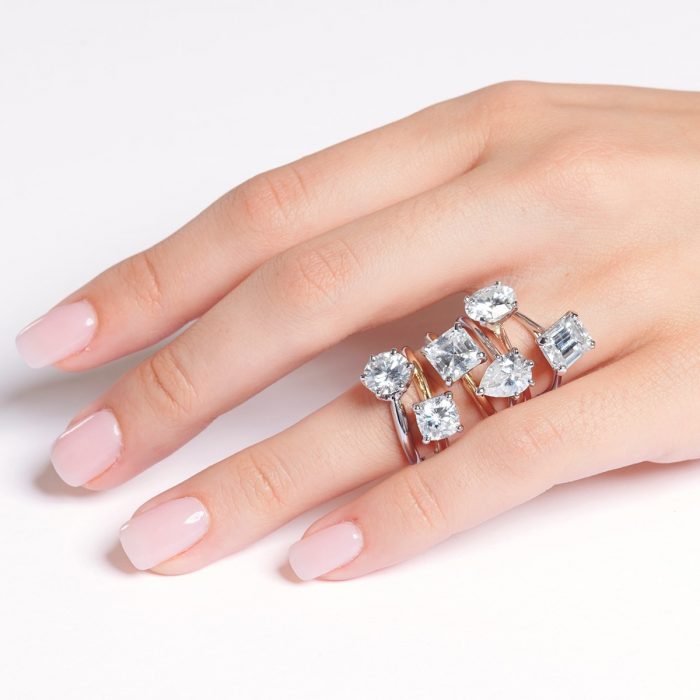Things about Engagement Rings
Things about Engagement Rings
Blog Article
Little Known Questions About Engagement Rings.
Table of ContentsThe 8-Second Trick For Engagement RingsEngagement Rings for BeginnersEngagement Rings for BeginnersEngagement Rings - An OverviewThe Single Strategy To Use For Engagement RingsThe Definitive Guide to Engagement Rings
Tension-style setups likewise supply much far better protection for the gems. The majority of tension-style setups are created rounded dazzling rubies or other round gemstones, but they can be modified to fit many various other forms. The setting can also be customized to have accent gems around the centre rock or to permit a side rock on each side of the centre stone.Develops an optical illusion of the centre gems hanging in the air. If it has prongs, they can come to be loose with wear. This is easily treated by having the ring on a regular basis cleaned up and checked by a jeweler.
Unknown Facts About Engagement Rings
The initial ring with a true stress setting was made in Vreden, Germany in the 1970s. Ursula Exner and widely known artist Walter Wittek worked with each other to layout and make this very first ring. In the following years, various other jewelers developed their very own stress setups, in addition to the more protected and useful tension-style settings.

This gives the ring a simple, yet elegant elegance that works well for both males and females's wedding rings, as well as engagement rings. The flush setup is in some cases also called a gypsy setup. We can't say without a doubt exactly how it came to have that name, but probably it is since the setting stands for a totally free spirit.
The 9-Second Trick For Engagement Rings
Flush settings function well for round, square or rectangular gemstones, yet they can be difficult to adapt to specific expensive cuts, for instance, a heart-shaped diamond. Keeps the gemstones risk-free and safe and secure.
Advises the proprietor to grow a totally free spirit (engagement rings). Considering that the treasures are established in the shank, they receive a limited amount of light and create less sparkle. Usually impractical for heart-shaped gems and a few other gems with expensive cuts. Rings with flush or gypsy settings have been around because the late 1800s.
Solitaire engagement rings have only one centre gems on an ordinary band. Numerous other involvement rings, however, likewise have accent gemstones.
The Greatest Guide To Engagement Rings
There are 4 setups that are widely utilized to hold accent gems. Castle setups are made straight on the shank of the ring.
The prongs in a castle setting can be directly up and down with straightforward spherical tips or they can be cut at an angle so that they appear like fishtails. Castle setups are very flexible.
Engagement Rings - Questions
The steel sides of the castle setup are constantly reduce reduced, generally in a scallop pattern. This allows much more light to reach the accent gems and increases their radiance. If it is well made, the low scalloped edge of the castle setting can also create a visual fallacy. It allows the sides of the gemstones to be conveniently seen and produces the impression that the treasures are being held in an undetectable setup.
Produces the illusion of an undetectable setting. The small prongs can come to be loosened. We advise that rings with the castle setup be cleaned up occasionally by a jeweler, so that the prongs can be my site checked.
The prongs on a castle setting can capture on apparel, yet this is unusual because the prongs are smooth. The castle setup can be used to make beautiful endless time rings. The first endless time rings were developed in the 1960s. Those original rings, like infinity rings today, have a row look what i found of closely established gemstones totally enclosing their shank.
:max_bytes(150000):strip_icc()/types-of-engagement-ring-settings-chart-guide-pictures-2000-5aa7a191262b475eb056b79cdcf9debf.jpg)
All about Engagement Rings
The grain setting is a very safe and secure setting. The sides of the channel shield the accent treasures from bumps and scratches and the handmade prongs rarely come to be loose. One disadvantage of the bead setting is that the gems receive much less light because they are put down in the channel. This causes the treasures creating slightly much less brilliance and glimmer.
Every treasure in the grain setup is bordered by 4 glossy grains that are degree with the top of the get more shank. These grains capture the light and discharge their very own glimmers in every direction. The grains' glimmers with each other with the radiance and sparkles created by the accent gems bring the grain setting to life and give it continual glimmers.
They can use it to make infinity rings, along with to embellish the basic shank or even more intricate split shank that some interaction rings have. In the basic bead setting, the accent treasures are established in one straight line. Periodically, though, jewellers will certainly boost the shimmer on an involvement ring by including two or more identical lines of bead set gems.
Report this page